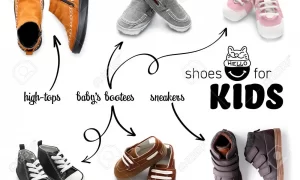
Your old shoes are worn out and you need a new pair. A frequently asked question in our practice is; ‘What are good shoes?’ This is immediately a difficult question, because not every shoe is suitable for everyone. When buying shoes you have to look carefully at what your foot needs. If you have a wider foot, it is useful if you also look at a shoe that is a bit wider.
Moreover, everyone knows the following situation. You see a nice shoe in the store. It fits well in the store, but at home you find out after wearing it that it is just a bit too big or pinching. Sin!
Tip 1: Buy the shoes preferably in the afternoon!
Our feet are somewhat swollen as the day progresses due to moisture retention, so it is advisable to buy shoes in the afternoon and not in the morning. It may just be that the shoes you bought in the morning still pinch in the afternoon.
Tip 2: Wear socks that you normally wear!
When trying on shoes, bring socks that you normally wear. If you try on a shoe with a thin sock and you normally wear thicker socks, it may be that the shoe is too tight or vice versa.
Tip 3: Don’t focus on the size of a shoe!
Have you always had a size 37? And now you don’t come in a size 37 anymore? It is wrong to think that you always need the same shoe size. Any size can have a different size for brand A than for shoe brand B. It is best that you try several sizes and buy the shoe that fits your foot best.
Tip 4: Buy the right size!
There are a number of ways to check if the shoe is the right size. The foot can of course be measured with a size gauge, with which the exact size is determined.
If this is not at hand, you can press the big toe up when you have the shoe on. With the thumb you can then feel how much space is left. It is best to let someone else do this, because they can do it best. When there is approximately a 7 mm space left, this is sufficient. The space should be about a finger’s width thick.
Another way you can use is to put a thumb behind the heel of the shoe, if this is not possible then the shoe is too small.
Tip 5: Pay attention to the width of the shoe!
It is not the intention that a shoe will pinch. So always pay attention to the width of the shoe, especially if you have a wide foot. Make sure that when you are wearing the shoe that the foot does not push the shoe out of shape. If this is the case, you do not need a larger size, but a larger width. If you can move the foot from left to right in the shoe, then the shoe is too wide and you should look for a narrower shoe and not a smaller shoe size.
Pay attention! Not all brands keep the same width sizes, so there may be a difference.
It is also true that shoes tend to flare out slightly with use and become more flexible. However, if the shoes are already pinching in the store, they won’t help. Then look for a suitable model.
Tip 6: Pay attention to stitching and seams!
If you have sensitive feet, diabetes, rheumatism or lumps on the feet, it is important to make sure that there are no stitches and seams over, for example, the lumps. This is because the shoe cannot expand at this point and a pressure point can be caused. It is also important for diabetes and rheumatic patients that there are no stitches and seams in the interior, which can cause pressure points and in the worst case wounds.
Tip 7: Pay attention to the bending point of the sole!
A shoe should not be too flimsy. That is why it is important to pay attention to the inflection point when buying the shoe. If the bending point is not in the right place, this can cause forefoot complaints in the future, for example. The outsole should also not bend in the middle, if it can, then the shoe is too soft.
Tip 8: Pay attention to the thickness of the sole!
The thickness of the outsole affects the comfort while walking. When you walk on a very thin sole, you feel every stone much easier, because there is less cushioning when walking. A thick sole does this more and is also more suitable for people who have to stand and/or walk a lot during the day.
Tip 9: Ensure a well-closing heel part!
The heel part, also called the counterfort, is located at the back of the shoe at the heel. It should fit snugly around the heel. Then it keeps the foot in place while standing and walking. So walk up and down a few times when trying on the shoes. If you slide your foot or slip out of the shoe with the heel, the heel part will not fit and may be too wide.






